《主な内容》
侍が日本人初世界一周した Samurai were the first Japanese to travel around the world.
地球一周の旅 遣米使節の行程 The trip around the world
■ポウハタン号で渡米:日本〜(太平洋)〜ハワイ〜サンフランシスコ〜パナマ U.S.S.
Powhatan (2,400 ton): Japan(Shinagawa Offing) → Pacific Ocean → Hawaii → San Francisco → Panama
・パナマ地峡を汽車で越えるーアスペンウォール(大西洋側)
■ロアノウク号でカリブ海を渡る:アスペンウォール〜ワシントン U.S.S.
Roanoke (3,400 ton): Aspinwall (modern day Colon, Panama) → Caribbean Sea →
Washington
・ワシントンからはーボルチモアーフィラデルフィアーニューヨークへほとんど鉄道で移動
■ナイアガラ号で帰国:ニューヨーク〜(大西洋)〜ロアンダ(アフリカ・アンゴラ)〜バタビア(インドネシア)〜香港〜日本 U.S.S. Niagara (4,800 ton): New York → Atlantic Ocean → Indian
Ocean → Batavia → Hong Kong →Japan( Shinagawa Offing)
米国海軍軍艦三隻を乗り継いで世界一周した万延元年(1860)の遣米使節。
米艦3隻を乗り継いでアメリカ、アフリカ、香港で見たものは何か
小栗上野介はアメリカでの見聞を日本にどう活かしていったか
横須賀造船所/中小坂鉄山開発/日本最初の株式会社/フランス語学校/軍制改革……
<Main Contents>
The First Japanese Samurai to Travel Around the World
The trip around the world - Itinerary of the Japanese Mission to the United States
■ U.S.S. Powhatan (2,400 ton): Japan (Shinagawa Offing) → Pacific Ocean → Hawaii → San Francisco → Panama City
They crossed the Panama Isthmus by train and arrived at Aspinwall on the Atlantic Ocean side.
■ U.S.S. Roanoke (3,400 ton): Aspinwall (modern day Colon, Panama) → Caribbean Sea → Washington
They traveled from Washington to Baltimore, Philadelphia and New York mostly by train.
■ U.S.S. Niagara (4,800 ton): New York → Atlantic Ocean → Luanda (Angola) → Indian Ocean → Batavia (Indonesia) → Hong Kong → Japan (Shinagawa offing)
* In 1860, the first year of the Man'en Era, the Japanese mission to the United States traveled around the world on three U.S. Navy warships.
* What did they see in the U.S., Africa, and Hong Kong while traveling on three U.S. warships?
* How did Kozukenosuke Oguri apply what he learned in the U.S. to Japan?
* Yokosuka Shipyard, Nakaosaka Iron Mine Development, Japan's First Stock Company, French Language School, Military Reform, etc.
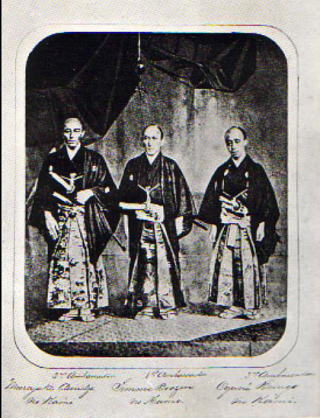
(写真)左から Pictured from left:
遣米使節 The First JapaneseDelegation to the United States
副使 村垣淡路守(40歳) Vice Ambassador Muragaki Awaji no Kami (40
years old)
正使 新見豊前守 (48歳) Chief Ambassador Shinmi Buzen no Kami (48 years old)
監察 小栗豊後守 (34歳)Observer Oguri Bungo-no-Kami (34 years old)
世界一周航路図 A Map of the Delegation’s Journey around the World
世界一周をした使節一行の航路 The route
of the delegation around the world
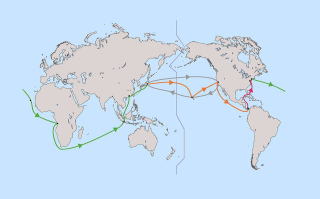
赤い線 日本〜サンフランシスコ〜パナマ〜ワシントン Red Line Japan → San Francisco → Panama → Washington D.C.
緑の線 ニューヨーク → 日本 Green Line New York → Japan
灰色の線 咸臨丸 日本 → サンフランシスコ → 日本 Gray Line KANRINMARU Japan → San Francisco → Japan
万延元年(1860)一月十八日築地を出発し、ハワイ〜サンフランシスコ〜パナマ。汽車で太西洋側へ出てワシントン上陸、フィラデルフィア〜ニューヨーク〜アフリカ〜インド洋〜香港〜品川に九月帰着。約九ヶ月の旅であった。
The delegation left Tsukiji in Tokyo, Japan on February 9, 1860 (January 18th of Man'en 1 in Japanese calender) and the next day departed from the port at Yokohama, in Kanagawa Prefecture. From there they sailed to Hawaii, San Francisco and Panama City.Next, the delegation crossed the Panama Isthmus by train to the Atlantic Ocean side and then traveled by ship to the East Coast of the U.S., eventually arriving at Washington DC. They then proceeded to Philadelphia and New York before leaving for Africa by ship. From Africa they travelled through the Indian Ocean to Hong Kong and finally returned to Shinagawa in Tokyo, Japan in November 10, 1860 (September 28 of Man'en 1). In total, their journey took nine months.
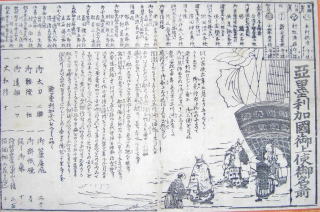
▲遣米使節の出発を伝える瓦版(東善寺所蔵)▲ A print showing the departure of the delegation (Collection of Tozenji
Temple.)
遣米使節三船
Three Ships That Carried the First Japanese Embassy to the United States
and Around the World
■ポウハタン号(2,400トン)米国海軍軍船 U.S.S. Powhatan (2,400 ton U.S. Frigate)
外車輪を備えた帆船。安政7(1860)年1月18日(西暦2月9日)、遣米使節一行77名はポウハタン号で太平洋を越えて渡米した。パナマまでこの船で航海し、西洋式の船の構造、操船の仕組み、蒸気機関の性能、米国海軍士官と兵卒の関係、アメリカ人の屈託のない明るい人情、大嵐の中での親切に触れ、理解を深めた。
The U.S.S. Powhatan was a sailing frigate equipped with side wheels. The
ship departed from Japan on February 9, 1860 to cross the Pacific Ocean
to the United States with a 77-member Japanese delegation aboard. The delegation
continued its voyage on the Powhatan to Hawaii, San Francisco, then to
Panama City. During its voyage, the members of the Japanese delegation
increased their knowledge of the mechanics and operation of Western ships,
the capability of the steam engine, as well as, the relationship between
naval officers and common soldiers. Moreover, the deleagation came to appreciate
the kindness of their light-hearted American shipmates during their journey
on the stormy seas.
□船名の「Powhatan」…ネイティヴアメリカンの首長で、デイズニーの物語「ポカホンタス」の父の名前。
The name “Powhatan” originates from the name of a Native American chief and is also the name of the father of Pocahontas.
嵐の海をゆくポウハタン号 A drawing depicting the Powhatan at sea during a storm
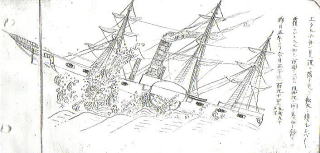 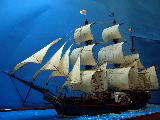 模型制作:岡崎英幸・東善寺蔵 模型制作:岡崎英幸・東善寺蔵
▲佐藤籐七「渡海日記」(小栗忠順従者の記録)所載)より
This drawing appears in “Tokai Nikki (Diary of Crossing the Pacific Ocean)” by Toshichi Sato, a member of the delegation who served as attendant to Tadamasa Oguri (aka Kozukenosuke Oguri).
日本人は慣れない航海と嵐で船酔いに苦しめられた。The Japanese were not accustomed to such voyages and suffered with sea
sickness during their journey.
ハワイ島にて 2月14日(3月5日)〜2月27日(3月18日)A Stop in Hawaii (March 5th to March 18th)
大嵐で消費した石炭、水を補給するため、予定を変えて立ち寄ったサンドウィッチ島(ハワイ)はすっかり欧米風の建物が立ち並び、週間新聞が二紙も発行されているのを見た。
After weathering severe storms at sea, the Powhatan stopped in Hawaii (at
that time known as the “Sandwich Islands”) to replenish their supplies
of coal and water. Once on the island the Japanese delegation saw Western
style buildings constructed in rows and learned about the two weekly newspapers
published on the island.
カメハメハ四世夫妻 Visit with King Kamehameha IV and His Queen
2月18日(西暦3月9日)王宮に招かれ挨拶を交わした。
On March 9, the delegation was invited to the royal palace of Kamehameha
and met with the king and his Queen.
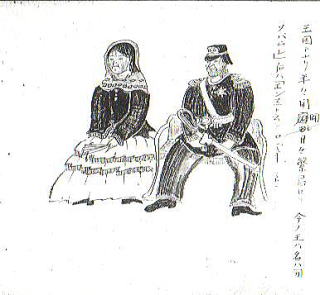
▲佐藤籐七「渡海日記」(小栗忠順従者の記録)所載)より The above drawing appears in “Tokai Nikki (Diary of Crossing the Pacific Ocean)” by Toshichi Satoi, a member of the delegation who served as an attendant of Tadamasa Oguri (Kozukenosuke Oguri).
サンフランシスコ・メーア島の海軍造船所
Visit to the Mare Island Naval Shipyard
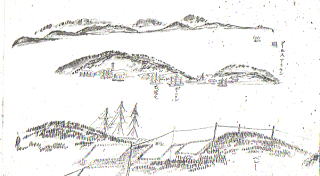
3月9日(3月29日)〜3月18日(4月7日)From March 29 to April 7
大嵐による故障を修理している咸臨丸とここで再会し、互いの無事を喜び合った。サンフランシスコから帰国する咸臨丸と別れポウハタン号はパナマへ向かった。
The delatation on the Powhatan stopped at Mare Island (a peninsula 23 miles
Northeast of San Francisco) and were reunited with their fellow Japanese
aboard the Kanrin Maru which was under repairs at the Navy Yard having
after sustaining damage in stormy seas. From Mare Island, the delegation
aboard the Powhatan would proceed to Panama City while the Japanese crew
and escort group aboard the Kanrin Maru returned to Japan directly from
San Francisco.
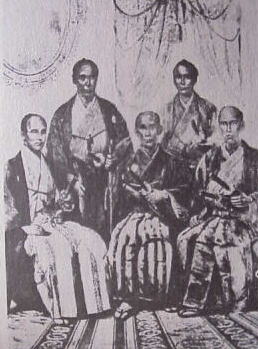
▲遣米使節ーサンフランシスコにて
森田清行 成瀬正典
不明 ・監察小栗忠順・ 不明
▲ Some delegation members in San Francisco
Kiyoyuki Morita Masanori Naruse
Unknown Tadamasa Oguri, the censor Unknown
咸臨丸(292トン) Kanrin Maru corvette (292 ton)
遣米使節団の乗船ポウハタン号の護衛船として浦賀〜サンフランシスコ間を往復航海した、オランダ製のスクリユー船。じつは、「日本初の太平洋横断」は250年前に田中勝介や支倉常長がしているし、「日本人だけで航海」という話もブルック大尉ら11名が乗り込んで暴風雨の北太平洋を乗り切ってくれたからいずれも「咸臨丸の虚構」といえる。
The Kanrin Maru, a screw-drive steam corvette built in Holland, made the
voyage from Uraga, Japan to San Francisco as an escort ship to the Japanese
delegation aboard the U.S.S. Powhatan. It is said that the Kanrin Maru
was the first Japanese ship to sail across the Pacific Ocean and that it
was operated only by Japanese. In reality, however, the first Japanese
crossing of the Pacific Ocean was made about 250 years ago by Katsusuke
Tanaka and Tsunenaga Shikura, and 11 Americans including Captain John Mercer
Brooke boarded the Kanrin Maru and survived the stormy North Pacific Ocean.
Therefore, all such rumors can be said to be fictions about the Kanrin
Maru.
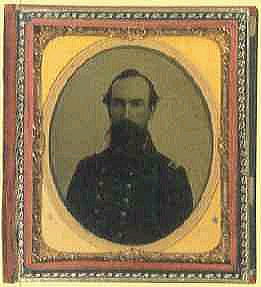
▲ブルック大尉 American Lieutenant Brooke,
□明治以来の学校教育では咸臨丸を宣伝し、使節一行の業績を、小栗上野介の業績とともに、意図的に表に出さない。今後は教科書から咸臨丸を外して「ワシントン海軍造船所見学」の写真を入れるべきである。
Since the Meiji period, the role of the Kanrin Maru has been emphasized
and the accomplishments of the Japanese delegation aboard the Powhatan,
including Kozukenosuke Oguri, have been played down in standardized school
texts in Japan. In the future, however, the picture of the Kanrin Maru
should be removed from textbooks and, instead, the photo showing the Japanese
delegation visit to the US Navy Shipyard in Washington D.C., which led
to the construction of the Yokosuka Shipyard, should be included.
■ロアノウク号(3,400トン)米国海軍軍艦 U.S.S. Roanoke (3,400 ton )U.S. Frigate
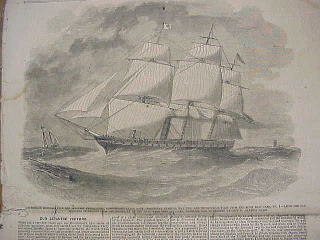 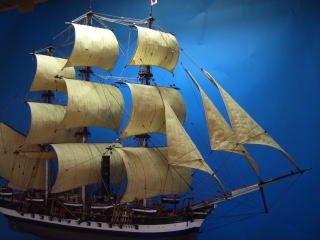 模型制作:岡崎英幸・東善寺蔵 模型制作:岡崎英幸・東善寺蔵
▲ニューヨーク・サンディフック沖を進むロアノウク号
フランクレスリー・イラスト新聞 1860年(万延年)5月26日(東善寺所蔵)
An illustration of the Roanoke sailing past the Sandy Hook barrier peninsula near New York from Frank Leslie’s Illustrated Newspaper, May 26, 1860 (Collection of Tozenji Temple)
アスペンゥオール(パナマの大西洋側)〜ワシントンへ遣米使節を運んだ米国軍艦。パナマで一年近くも使節を持っている間に病人が出て二人の水兵が病死。使節一行は水葬場面に立ち会って艦長以下全員が会葬するのに驚き、感動している。日本では部下の葬儀に上司が会葬する習慣はなかった。
The U.S.S. Roanoke carried the Japanese delegation across the Caribbean
Sea from Aspinwall (modern day Colon, Panama) to Washington. In Panama,
when two U.S. sailors become ill and died, a funeral was held at sea and
the entire crew including the ship’s captain participated to pay their
respects to the deceased. The Japanese envoys were surprised and moved
to see the captain and other high-ranking officers at the ceremony since
it was unheard of in Japan at the time for higher ranking officers to take
part in the funeral of a low-ranking seaman.
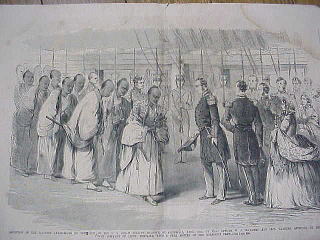
▲ロアノウク号に乗船する使節一行 万延元年3月7日(4月26日)
The Japanese delegation boards the U.S.S. Roanoke (April 26th 1860)
品川沖〜ハワイ〜サンフランシスコで咸臨丸と別れパナマに着いた使節一行は、汽車で大西洋側へ出て、迎えに来ていたロアノウク号に乗り込んだ。
After traveling from the Shinagawa Offing, Japan, to Hawaii and then San
Francisco aboard the Powhatan and in tandem with the crew of the Kanrin
Maru, the Japanese delegation parted with the crew of the Kanrin Maru and
sailed to Panama aboard the Powhatan. From there they crossed the Isthmus
of Panama by train and boarded the awaiting U.S.S. Roanoke.
フランクレスリー・イラスト新聞 1860年(万延年)5月26日(東善寺蔵)
Above scene is from the from Frank Leslie’s Illustrated Newspaper, May
26, 1860. (Collection of Tozenji Temple)
鉄の国アメリカ (5月4日〜7月1日)
使節一行は、町外れに古くなって捨てられ、誰も拾わない鉄製品に驚いた。「この国は鉄があふれている!」。「ホテルの柵が鉄」でできてる。町外れの川にかかる橋は「鉄の橋である。こういう橋が五つもかかっている」(加藤素毛・岐阜県下呂市出身の従者)と書いて、「木と紙の国日本」から来て驚いた「鉄の国」アメリカを伝えている。
同じくショックを受けた小栗忠順が目指したのは「日本を鉄の国に改革したい」ということ。「ネジ一本作れない国」から早く脱皮するには、何から手をつけたらいいのか……。
America: The Country of Iron (May 4th to July 1st)
During their stay in the United States, the Japanese delegation was shocked to see scrap piles of iron laying unused at the edges of towns. Attendant Somo Kato expressed his surprise at the abundance of iron. His writings from the visit state, “This country is overflowing with iron!” and later he writes, “The hotel’s fence was made of iron!” After coming across bridges built with iron outside of town he observed, “The bridges are made of iron and there were five of them.” Clearly he was surprised at the scale of iron usage in America, having come from Japan which was a mainly a country of wood and paper at the time.
Delegate Tadamasa Oguri was also shocked to discover the use of iron in the United States and he vowed to determine the best way to reform Japan from “a country that cannot make even one screw” into a “country of iron” as quickly as possible.
ワシントン海軍造船所での見学
Observational Visit to the Naval Shipyard in Washington D.C.
5月25日ワシントン海軍造船所を見学した。ここは造船だけでなく、製鉄をもとにネジやボルトから大砲や小銃、砲弾まで次々に作るー大総合工場だった。小栗は日本を鉄の国に造り変えるための総合工場として「日本の近代化はこの施設・造船所を日本に作ることから始まる」と確信した。
On May 25, the Japanese delegation visited the U.S. Navy Yard in Washington D.C. The shipyard contained a large integrated factory that produced iron for screws and bolts, as well as, bullets and small firearms. Upon seeing this factory, the censor, Tadamasa Oguri (aka Kozukenosuke Oguri) became determined to build a similar integrated factory in Japan to modernize Japanese buildings and ships and transform Japan into a country of iron.
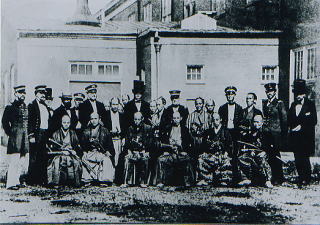
▲前列右から二人目が監察小栗豊後守忠順、正使新見豊前守、副使村垣淡路守。正使の背後は、造船所提督ブキャナン
Photo: Beginning second from the right is Observer Oguri BUngo-no-Kami
Tadamasa, Chief Ambassador Shinmi Buze-no-Kami, and Vice Ambassador Muragaki
Awaji-no-Kami、the three official ambassadors. Directly behind Ambassador Shinmi is Admiral Buchanan, U.S. Navy Yard head of the shipyard.
当時、写真を印刷する技術がなかったので、写真をもとに銅版画にして新聞で報道した。
The above group portrait was done with a
copperplate print since the technology to develop photos did not exist at the
time. This copperplate was used for the newspaper article
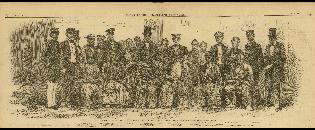
▲フランクレスリー・イラスト新聞 1860年(万延年)6月6日(東善寺所蔵)
From the Frank Leslie’s Illustrated Newspaper in June 6th 1860 (collection of Tozenji temple)
東洋からの珍客・日本人 The Japanese Delegation: Unusual Visitors from the East
はじめ日本人を好奇の眼で見ていたアメリカ人は、やがて彼ら日本人が知的好奇心に満ち、礼儀を重んじ、品格があり、衣服の布地や刀のこしらえなどに精微な工芸技術を持っていることに驚嘆し、ワシントン、フィラデルフィア、とニューヨークに近付くにつれ大人気となって、日本ブームを引き起こした。
Americans first viewed the Japanese delegation with great curiosity. Before long they came to see them as a people who are extremely polite and full of intellectual curiosity and class; the Americans admired the craftsmanship of the Japanese visitors’ beautiful and intricate clothing and swords. Throughout their travels in Washington, Philadelphia, and New York, the delegation was very popular kicking off a popular interest in Japan.
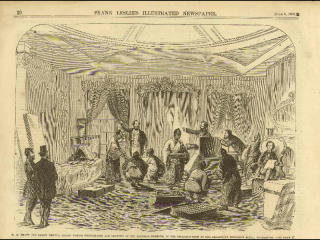
贈物の撮影 Photography of Gifts from the Japanese Delegation
▲ウイラードホテルで日本から大統領への贈物を開いて、写真師M.B.ブラディが撮影し、新聞社の絵師がスケッチした。
During their stay at the Willard Hotel in Washington D.C., the delegation
opened the package of the items that they brought as gifts for the President,
which were photographed by photographer M. B. Brady and then sketched by
artists for the newspapers.
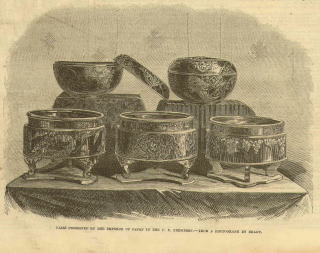
▲贈物は、太刀一振、馬具(鞍と鐙は蒔絵)掛け軸10幅(狩野・住吉両派の絵、翠廉(緑色のすだれ)、屏風10双、錦の幔幕、蒔絵の書棚、蒔絵の硯箱、蒔絵の料紙箱。
The gifts presented included long swords, riding equipment (the saddle
and stirrups with maki-e lacquer decoration) hanging scrolls (by artists
of the Kano and Sumiyoshi schools), ten pairs of folding screens, multicolored
hanging curtains, lacquered book shelves, lacquered inkstone cases, and
lacquered stationary boxes.
アメリカでは現在でもこういう土産は大統領の私物にならず、博物館に納めることになっている。日本では現在でもそういう規定はない。
Even today in the United States, such gifts do not become the personal
property of the President, but instead are placed in the care of a museum.
The same is not true in Japan.

▲ホテル出発ー官邸へ Leaving the Hotel for the White House
万延年3月28日(1860年5月18日)朝、ウイラードホテルを出てホワイトハウスに向かう。海兵隊や軍楽隊が烏帽子、狩衣の正装で馬車に乗った使節を護衛し、沿道いっぱいの見物人をかきわけて進んだ。
On May 18, 1860, the Japanese delegation left the Willard Hotel in Washington
for the White House. Dressed formally in traditional eboshi hats and silken
kariginu robes, and accompanied by navy soldiers and a military band, the
Japanese envoys made their way in a horse-drawn carriage to the White House,
through crowds of onlookers.
フランクレスリー・イラスト新聞 1860年(万延年)6月6日(東善寺所蔵)
From the Frank Leslie’s Illustrated Newspaper in June 6th 1860 (collection of Tozenji temple)
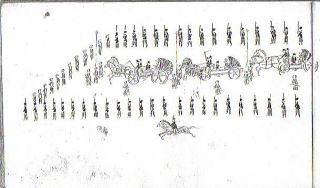
▲ホワイトハウスへ向かう行列 Procession
to the White House
ホテルの玄関で四頭立て馬車に使節が乗り込むたびに米国国歌が演奏され、槍持ちや家来が警護し家紋入りの旗が立つ。道路幅いっぱいを海兵隊が守って進んでいった。佐藤籐七「渡海日記」(小栗忠順従者の記録)所載)より
The delegation boarded their four-horse carriage at the front steps of
their hotel and began the procession to the White House accompanied by
a performance of the national anthem by the military band and protected
by their attendants carrying decorative spears and banners with family
crests. The procession’s route was packed as naval soldiers protected the
delegation. The above drawing appears in “Tokai Nikki (Diary of Crossing the Pacific
Ocean)” by Toshichi Sato, a member of the delegation who served as attendant
to Tadamasa Oguri (aka Kozukenosuke Oguri).
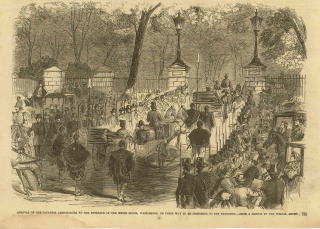
▲ホワイトハウスに入る一行 毛槍を立てた従者を先頭に、馬車を連ねてホテルの東南へ2キロ行くとホワイトハウス入口に着いた。ランクレスリー・イラスト新聞 1860年(万延年)6月6日(東善寺所蔵)
The group entering the White House
With the Japanese delegation’s attendants leading the procession carrying
decorative spears, the horse-drawn carriage carrying the official delegation
traveled for two kilometers before reaching the White House.
From Frank Leslie’s Illustrated Newspaper, June 6, 1860 (Collection of
Tozenji Temple)
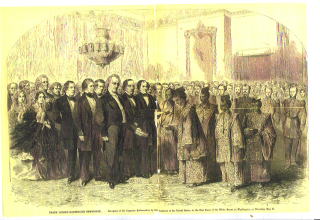
▲ホワイトハウスでブキャナン大統領に国書を渡す使節の様子を、新聞全紙で伝えた。フランクレスリー・イラスト新聞 1860年(万延年)6月2日(東善寺所蔵)
This drawing illustrates the delegation presenting President Buchanan with
a letter from the Japanese shogun. This drawing was printed as a full,
two-page spread by the newspaper.
From Frank
Leslie’s Illustrated Newspaper, June 2, 1860. (Collection of Tozenji Temple)
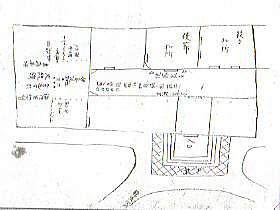
▲ホワイトハウス見取り図
Sketch of the White House Floor Plan
大統領はじめ米国政府の主だった人々が立ち並ぶイーストルームに小栗忠順ら三人の使節と、国書をもった成瀬正典(外国奉行支配組頭)、通訳の名村五八郎が入っていった。佐藤籐七「渡海日記」(小栗忠順従者の記録)所載)より
At the White House, the President of the United States and other high ranking government officials lined up in the East Room to greet the delegation. Tadamasa Oguri and other two Japanese envoys entered the room together with interpreter Gohachiro Namura and Masanori Naruse who carried an official letter from the government of Japan.
This floor plan sketch of the White House appears in “Tokai Nikki (Diary of Crossing the Pacific Ocean)” by Toshichi Sato, a member of the delegation who served as attendant to Tadamasa Oguri (aka Kozukenosuke Oguri).
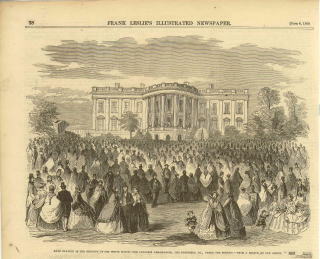
▲外務省主催歓迎会 Welcome Party Hosted by the U.S. Department of State
3月29日(西暦五月19日)、ホワイトハウス前庭に一万人が集まって歓迎会を開かれた。使節らは立ったまま(!)料理をご馳走になり、音楽が鳴るとダンスが始まった。そのやかましいこと、ダンスの様子もみるに堪えない、と早々に退散してホテルへ戻った。
フランクレスリー・イラスト新聞 1860年(万延年)6月6日(東善寺所蔵)
On May 19,
1860, a welcome party for the Japanese delegation was held on the front lawn
of the White House, and over 10,000 people attended the event. At the welcome
party, the ambassadors and elegation ate standing up (something they were unaccustomed to doing). As the music cranked up and dancing began ,the Japanese delegation could hardly believe their eyes. The loud music and unusual dancing made them uncomfortable, and they quickly retreated to their hotel.
From Frank Leslie’s Illustrated Newspaper, June 6, 1860 (Collection of Tozenji Temple)

▲スライド上映会
五月16日(西暦6月5日)、ウイラードホテルでランターン・スライド(幻灯)の上映会が行われ、ナイアガラの滝や、世界各地の珍しい風景を伴奏つきでみせてくれた。大統領がおしのびでやってきて皆と談笑しながら一緒に見た。終わるとお伴も連れずに帰って行く様子に、日本人は「大きな国の身軽な政府」を実感し、驚嘆した。
Lantern
Slide Show Viewing
On June 5, a lantern slide show viewing for the Japanese envoys was held
at the Willard Hotel. The slide show included images of Niagara Falls and
other unusual scenic spots around the world and was set to music. President
James Buchanan made an unobtrusive appearance at the event and engaged
in conversation with the envoys while enjoying the slide show together.
When the show finished, the delegation returned to their sleeping quarters
without further fanfare. They later remarked of their surprise at the casualness
of the U.S. government, considering the size of its country.
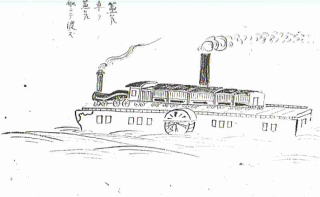
▲汽車を蒸気船で渡す
ニューヨークヘ向かう途中、フィラデルフィァ近くのサスケハナ川で、汽車ごとそっくり船に乗せて渡った。使節一行が見たアメリカ近代工業技術を示す最高のものはこれであろう。佐藤籐七「渡海日記」(小栗忠順従者の記録)所載)より
Put the train on a steamboat and crossed the river.
On their way to New York, the delegation boarded a paddle steam boat to cross the Susquehanna River, near Philadelphia. The delegation was very impressed with the steam boat technology and felt that it served as the best example of America’s industrial technology.
This sketch of the paddleboat originally appeared in the “Tokai Nikki (Diary of Crossing the Pacific Ocean)” by Toshichi Sato, a member of the delegation who served as attendant to Tadamasa Oguri (aka Kozukenosuke Oguri).
■日本と欧米の差は「鉄を大量に使うこと」にあると見た小栗忠順は、帰国後、横須賀製鉄所(造船所)建設でその差を埋めようとはかる。
Convinced that the strength of the U.S. lied with its use of iron, Kozunosuke
Oguri, the censor of the delegation, established an ironworks (later called
shipyard) in Yokosuka Japan, upon his return home to help close the gap
between the United States and Japan.

▲ブロードウエイの大歓迎
4月28日(西暦6月17日)、ニューヨークに着くと条約の箱を花や旗で飾った馬車に乗せ、パレードが始まった。ワシントン到着以来連日伝えられる日本人を一目見ようと見物の男女がひしめいた。次々に飾り立てて進行する音楽隊、騎馬隊、砲隊を台の上から観閲する。この日動員された軍隊は8千人だった。フランクレスリー・イラスト新聞 1860年(万延年)6月30日(東善寺所蔵)
Broadway Welcome Parade
On June 17, 1860, the delegation participated in a parade in their honor in New York. The parade began upon their arrival and they moved down Broadway in horse drawn carriages carrying the officially signed treaty on a carriage decorated with flowers and flags. Beginning with their arrival in Washington, the envoys' every move was reported upon, and large numbers of people came out to see them. Over 8,000 soldiers decked out in uniform were mobilized, including marching bands, cavalry, and artillery soldiers. .
From Frank Leslie’s Illustrated Newspaper on June 30, 1860. (Collection of Tozenji Temple)

▲ニューヨーク市長と会見
4月29日(西暦6月18日)、ニューヨーク市庁舎にウッド市長を訪問した。軍楽隊つきの護衛に守られてシティ・ホール公園に入り、庁舎に入った。米国の新聞によると日本人が同じ着物を着たのを見たことがない、というから使節らはたびたび服装を変えていたらしい。モーガン知事も同席していて、やはり挨拶した。副使村垣は不調でホテルで休養していた。
Meeting with the Mayor of New York
On June 18, the Envoys met with New York Mayor Fernando Wood at City Hall. An army marching band guarded the delegation as it proceeded through City Hall Park and into the government buildings. According to newspapers from that day, the Japanese envoys changed their attire often, and were never seen in the same formal attire twice. Governor Morgan also attended the event and met with the delegation. Vice Envoy, Muragaki, remained in his hotel room and did not attend the event because he was under the weather.
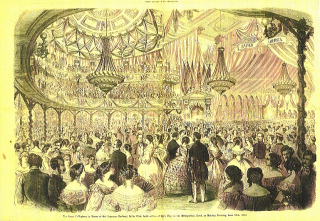
▲歓迎大舞踏会
5月7日(西暦6月25日)、ニューヨーク・メトロポリタンホテルで日本使節一行を歓迎する大舞踏会が開かれた。入場券(一人10ドル)が一万枚も用意され、楽団が五つも入ったものだった。
Welcome Grand Ball
A Welcome Ball was held for the Envoys at New York’s Metropolitan Hotel on June 25. Tickets to the ball cost $10 dollars, and over 10,000 tickets were issued. There were five bands that played at the ball.
■ナイアガラ号(4,800トン)米国海軍軍艦 U.S.S. Niagra (4,800 ton U.S. Frigate)
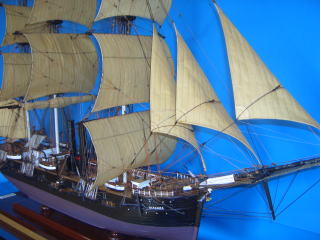 模型制作:岡崎英幸・東善寺蔵 Model created by Hideyuki Okazaki, Tozenji Collection 模型制作:岡崎英幸・東善寺蔵 Model created by Hideyuki Okazaki, Tozenji Collection
▲米国海軍の最新鋭軍艦ナイアガラ 乗組員466名、長さ114m、巾18m
ニューヨーク〜大西洋〜ロアンダ(アンゴラ)〜インド洋〜バタビア〜香港〜日本ヘ使節を運んだ。
The U.S.S. Niagara was at the time a state of the art battleship with a capacity of 466 crewmen,
a length of 114 meters, and width of 18 meters. The U.S.S. Niagara carried
the Japanese delegation back to Japan, traveling from New York across the
Atlantic Ocean to Luanda (Angola), across the Indian Ocean to Batavia (present-day
Jakarta, Indonesia), then to Hong Kong, finally arriving in Japan.
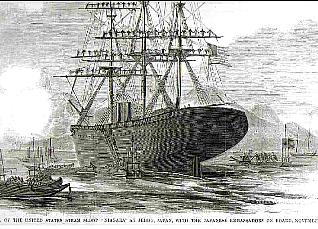
▲万延元年9月29日(11月11日)November 11. 1860
品川沖で遣米使節一行が下船するのを見送っている。最高の儀礼「登檣礼」で、ヤード(横桁)に船員が並び、「ごきげんよう」と声を三度あげて客を見送った。
ハーパーズ・ウイークリー新聞 米国海軍資料局提供・東善寺
The drawing depicts the Japanese delegation disembarking from the Niagara as the American crew mans the yards (lines up across the ship’s crossbeam as a formal send-off). The crew yelled “Banzai!” (Hooray!) three times to Japanese delegation in a symbolic gesture.
This drawing originally appeared in Harper’s Weekly and was provided to Tozenji Temple by the United States Navy’s Historical Department
バタビア(インドネシア)の造船所 The
Batavia Shipyard
横須賀造船所ができるまで、幕末に外国から買った蒸気船は、故障すると、上海やバタビアへ曳いてきて修理をしていた。
佐藤籐七「渡海日記」(小栗忠順従者の記録)所載)より
Before the shipyard was completed in Yokosuka, Japan, foreign-made steamships purchased until the end of Shogunate rule were towed to Shanghai or Batavia (Indonesia) for repair.
The above drawing appears in “Tokai Nikki (Diary of Crossing the Pacific Ocean)” by Toshichi Sato, a member of the delegation who served as attendant to Tadamasa Oguri (aka Kozukenosuke Oguri).
■三船の平面図 Sketches of the Three Ships' Floor Plans
 ポウハタン号POWHATAN ポウハタン号POWHATAN
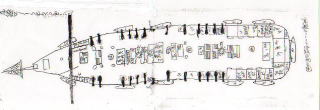 ロアノウク号 ROANOKE ロアノウク号 ROANOKE
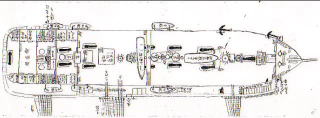 ナイアガラ号 NAIAGARA ナイアガラ号 NAIAGARA
▲ 加藤素毛画 by Katoh Somoh 加藤素毛記念館蔵 Sketches by Somoh Katoh (Collection of the Katoh Somoh Memorial Museum)
■小栗上野介にとっての「遣米使節の旅」
The
Impact of the Delegation’s trip to the United States on Observer Oguri Bungo-no-Kami
小栗上野介がこの旅で得たものは大きい。訪ねたアメリカは南北戦争直前で、2年後のアメリカ南部を書いた映画が「風とともに去りぬ」。そして帰国後8年間の日本は、新撰組と攘夷を叫ぶ浪士が斬り合いを繰り広げていた。江戸っ子の小栗上野介は「そんなことやっている場合じゃねえよ」と言いたかったであろう。見てきたものはあまりに大きく、どこから手を付けたらいいか戸惑いながら、日本の構造改革に突き進んでゆく。「親の病気が重く、もう治る見込みがないから、といって薬を与えないのは孝行ではない」とつぶやきながら…
Oguri Bungo-no-Kami (aka Kozunosuke, or Tadamasa) was strongly influenced
by his trip to the United States and subsequent travels while returning
to Japan. His visit to the United States took place just prior to the American
Civil War. Following his return to Japan, the country was embroiled in
eight years of internal strife in which faction warriors such as the Shisengumi
and the Neo-Confucianist Sonno joi (“Revere the Emperor, Expel the Barbarians?”) movement to overthrow the
Tokugawa shogunate at the end of the Edo period. Oguri must have surely
thought these internal quarrels were meaningless and worked to find constructive
ways in which he could apply what he learned on his voyage to the United
States and across the world. Oguri dived head first into Japan’s structural
reformation while maintaining support for the shogunate. He used the metaphor
that if one’s parents are dying of a serious illness, it is the role of
a devoted child to attend to them on their deathbed.
■遣米使節小栗上野介が帰国後にしたこと
Oguri Kozukenosuke’s Accomplishments after his return to Japan
|
業 績
|
|
Oguri’s Accomplishments
|
|
横須賀造船所の建設
|
ワシントン海軍造船所見学を契機としたこの造船所は、「日本近代重工学のいっさいの源泉」となって日本の近代化を支えた。
|
Establishment of the a shipyard in Yokosuka
|
After seeing the Navy Yard in Washington, Oguri felt that the establishment
of a shipyard could help modernize Japanese industry
|
|
中小坂鉄山(下仁田町)の開発
|
日本を鉄の国にするための鉱山を探した
|
Development of Nakaosaka area
|
To transform Japan into a country of iron, a mill was established in Nakaosaka
iron excavation begun
|
|
日本初の株式会社の設立
|
兵庫商社、築地ホテル、小布施の船会社(構想)など
|
Establishment of Japan`s first stock corporation
|
He established the
Hyogo Trading Company, Tsukiji Hotel, and the Obuse Ship Company (framework)
|
|
西洋式陸軍制度の導入と訓練
|
横浜で仏人教師による訓練が始まった。
|
Introduction of the western military system and
training methods in Japan
|
Training was
initiated under a Frenchman in Yokohama.
|
|
仏蘭西語学校設立
|
横浜に開校し幾多の人材を送り出した
|
Establishment of a French language school
|
This school was established in Yokohama and trained a
large number of Japanese
|
|
提唱したこと
|
|
Measures advocated by Oguri upon his return
|
|
ガス灯の設置
|
アメリカのホテルも町も明るかった。
|
Usage of the Gas Lamp
|
Oguri was impressed by the usage of gas lamps to brighten hotels and streets
in the United States.
|
|
郵便電信制度の設立
|
アメリカでは実行されていた。
|
Establishment of a Postal/Telegram System
|
Oguri made note
of the effectiveness of communication in the United States using such systems
|
|
新聞発行
|
ハワイでも発行されていた。
|
Newspaper Publishing
|
During the
delegation’s travels they noticed that even Hawaii had newspapers.
|
|
鉄道建設
|
アメリカでの移動はほとんど鉄道だった。「江戸―横浜に建設したい」
|
Establishment of Railroads
|
The main mode of
transport in the United States at the time was the railroad. Oguri endeavored
to build a railroad from Edo (Tokyo) to Yokohama
|
■株式会社の理解と実践 Establishment
of a Stock Company in Japan
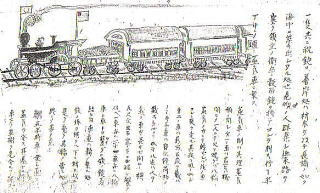
▲パナマ鉄道 Panama railroad
ポウハタン号から乗り換えたパナマ鉄道は、株式会社による経営だった。「建設費は700万ドル、資金を米国の商人が出資した鉄道組合で建設し、利用賃で経営して利益が出たら資本を出したものに配分する」という説明を聴いた小栗は、日本でも商人の財力で新しい事業を起こせる、と確信し、日本に株式会社を根付かせる端緒となった。
The railroad on which the delegation traveled in Panama was operated by
a stock corporation. The 7 million dollar construction cost to build this
railroad was financed by merchants who had formed an association for its
construction. The fare from train passengers paid the operating costs and
remaining profits were distributed to the merchant investors. Upon here
this, Oguri became convinced that he could harness the financial power
of merchants in Japan to start business. His conviction became the impetus
for the establishment of the first stock company in Japan.
パナマ鉄道は日本人を歓迎し、日の丸を掲げて使節一行を大西洋側アスペンウォールへ運んだ。The drawing depicts a train in Panama
flying the Japanese flag as it approached the Japanese delegation prior to
taking them to the Atlantic coast.
佐藤籐七「渡海日記」(小栗忠順従者の記録)所載)より
This drawing appears in “Tokai Nikki (Diary of Crossing the Pacific Ocean)” by Toshichi Sato, a member of the delegation who served as attendant to Tadamasa Oguri (aka Kozukenosuke Oguri).
■兵庫商社
兵庫開港に併せて、大阪の商人による日本初の株式会社「兵庫商社」の設立を提案し、鴻池ら大阪の有力商人20人で発足した。役員・定款も揃った日本最初の株式会社であったが、明治維新で解散してしまった。
Hyogo
Trading Company
Oguri advocated the establishment of a company to trade with foreign countries
in accordance with the opening of Hyogo harbor. The company was set up
by 20 powerful merchants, and it had both articles of association and a
board of directors. During the Meiji restoration the company was dissolved.
■小布施の「船会社」
北信州小布施の豪商高井鴻山は小栗の助言を元に、資本を集めて新潟の港に船会社を設立し、地域の物産を輸送販売することで、「国民利福」をめざしたい、という提案を行っている。
Obuse
Ship Company
Wealthy merchant Takai Koyama of Kitashinshu
Obuse raised capital to establish a ship company in Ehime Port on the advice of
Oguri. By doing so, Oguri proposed that the area’s products could be
transported for sale at other locations to improve the economy and welfare of
the entire country.
■築地ホテル Tsukiji Hotel
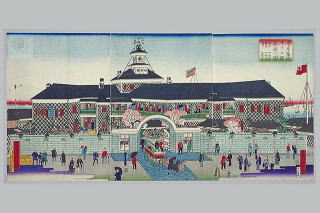
▲築地ホテル 絵・三代目広重 東善寺蔵 Tsukiji Hotel
清水建設二代の清水喜助は「江戸築地に資本を出し合って西洋式のホテルを立てれば、利益を出資者が分け合ってよい」という小栗上野介の提案を受け、株式会社の手法で築地ホテルを建設。慶応四年に完成した水洗トイレつきのホテルは、東京名所となった。
Shimizu Kisuke, inheritor of Shimizu Construction, took the advice of Oguri
Kouzukenosuke to establish a corporate entity to construct a western-style
hotel in the Tsukji area in Edo (Tokyo) and distribute the hotel’s profits
among investors. The hotel was completed in 1868 and became a Tokyo landmark.
■通貨の格差訂正交渉―金貨の分析実験 Negotiation
to Correct Currency Exchange Inequality and Testing of Coins
日本国内では元禄以来、小判金貨一枚を一分銀貨4個で換えていた。この相場をそのまま外国銀貨と一分銀貨との交換に利用され、安く交換された小判金貨が大量に外国へ持ち出されると、外国では小判金貨は三倍の値段でドル金貨に換えることが出来た。外国人にとってこんなうまい話はないから日本の小判金貨が大量に外国に流出していた。小栗はこれを食い止めるため、フィラデルフィアの造幣局で、小判金貨とドル金貨の全量の分析実験を強硬に申し入れ、実験に立ち会って相互の通貨交換比率に不平等があることを認めさせた。
Since the Genroku period, one gold koban coin was commonly exchanged for
four silver coins. However, when this system of exchange was applied to foreign
silver money, large quantities of koban (Japanese
gold coins) were exchanged in arbitrage for silver coins resulting in large
amounts of these gold coins being taken overseas. Outside of Japan, a single koban was then exchanged for three
dollar denominated gold coins making the transaction a windfall for foreigners.
Oguri wanted to stop this practice which was detrimental to Japan. To do so, he
strongly requested that the gold content of both the koban and U.S. gold coin be measured during the delegation’s visit
to the Philadelphia Mint. He carefully observed the testing on this occasion
and convinced the authorities to admit that the exchange rate being used was in
fact unfair.
■新聞発行提案
アメリカ各地で発行される新聞情報の速さを痛感し、帰国後、福沢諭吉に発行させることを計画し、幕府に提案したが、受け入れらなかった。
Suggestion
to Establish a Newspaper
During their travels in America, the
delegation became aware of the importance of the newspaper as a means of
communication in society. Upon returning to Japan, Oguri planned to launch a
newspaper in cooperation with Yukichi Fukuzawa but the plans were quashed by
the Japanese shogunate (bakufu).
■郵便電信の創設を提案
アメリカの主な町は電信で結ばれ、情報が瞬時に送られる。また、郵便により国民誰もが安く正確に手紙を届けられる。情報の速さ、正確さ、安さは国にとって有益とみて、帰国後「郵便電信制度の設立」を提案した。
Suggestion
to Establish a Postal and Telegraph System
At the time of the delegation’s visit to
the United States, large cities were already equipped with telegraphic
communication enabling quick spread of information. Moreover, the United States
had an established postal system that allowed anyone to inexpensively mail
letters. The Japanese delegation was impressed with these systems and the speed
and accuracy of information transfer in the U.S. Upon their return to Japan,
they proposed the establishment of a postal and telegraph system like that they
had seen on their visit.
日本の構造改革・「木の国」から「鉄の国」へ
使われなくなった鉄製品がゴミ捨て場に捨てられている国がアメリカだった。ホテルの柵は全て鉄、ワシントンの川には鉄の橋がいくつも架かっている。まさに「鉄の国アメリカ」・日本を「木の国」から「鉄の国」へ変える構造改革は、どこから手をつけたらいいのか、模索する旅で眼にしたのがワシントン海軍造船所だった。
Japan’s
Structural Reformation and Transition to a Country of Iron
The delegation was taken aback by the large scraps of iron stockpiled outside
of cities in the United States. The fences encircling hotels that they
stayed and bridges that they crossed were made of iron. Seeing this, the
delegation endeavored to devise a way to improve Japan’s industrial structure
and turn it into a country of iron. They saw their visit to the Washington
Naval Shipyard as a key to figuring out how to do so.
■横須賀造船所の建設
小栗忠順は帰国4年後に造船所建設を提案。多くの反対を押し切って慶応元年(1865年)に着工した造船所は「日本近代工学のいっさいの源泉」といえる総合工場となり、日本の近代化を支えた。
Establishment
of the Yokosuka Shipyard
Five years after the delegation’s return from their voyage and after much
opposition, Japan broke ground on the Yokosuka Shipyard. These facilities
would go on to become indispensible in supporting heavy industry and modernizing
Japan.
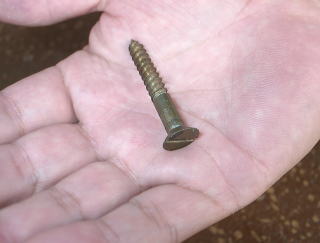
▲小栗忠順がお土産とした「ネジ」
ネジが珍しいからではない。「こういうものをどんどん造れる国にしたい」という意味が込められていた。(東善寺所蔵)
Oguri Tadamasa’s Souvenir Screws
It is said that Oguri’s purpose for
bringing screws back from the United States was not because they were a rarity,
but instead to demonstrate to others his conviction that Japan too should
become a country capable of producing such products.
■近代文明の表と裏を見た旅
A Journey Revealing the Insides and Outs of Modern Civilization
■アイスクリームを食べた最初の日本人
ワシントンへ向かう船で当時はアメリカでもぜいたくなアイスクリームをご馳走になり、日本人達は「アイスクリームは冷たくて美味しいものなり」と日記に書いた。
The
First Japanese to Eat Ice Cream
During their journey to Washington, the
delegation had a chance to try ice cream which was considered a luxury in the
United States at the time. A number of delegation members made mention in their
diaries of how delicious cold ice cream was.
■水洗トイレを使ったサムライたち
ワシントンなどのホテルには、すでに水洗トイレがあって、サムライたちは「栓をひねって」水を流し、使用した。
Experiencing
Flushable Toilets
The Japanese delegation’s rooms at their
Washington hotel were equipped with flushable toilets. It is believed that this
was their first experience with toilets that could be rinsed with the “pull of
a plug”.
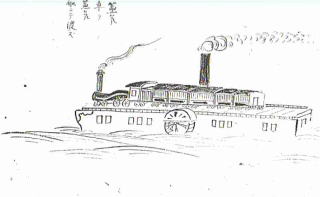
▲フェリー
■フェリー フィラデルフィア近くの橋のないサスケハナ河で、乗っている汽車ごとフェリーに積んで運ばれ欧米文化の先進性を痛感した。
Ferries
The delegation was impressed with U.S. and European modern transport, particularly
when their train was loaded aboard a ferry to cross the SASUKEHANA river
in Philadelphia.
■身軽な大統領
ワシントンを去る数日前、大統領が夜一人でホテルでのスライド上映会にやってきて、皆と見物し、終わると一人で戻っていた。将軍を絶対君主とする幕府政体では考えられない、大きいな国の身軽な政府を象徴する場面に驚嘆した。
The Approachability
of the U.S. President and the Nimbleness of Government
A few days prior to leaving Washington, the
President of the United States came alone to visit the delegation during a
slide show held in their honor at the hotel. The delegation was amazed at the
approachability of the President and the simplicity of American government
compared to the Shogunate.
◆強い文明が弱い文明を押さえつけ、上下の関係となってゆく姿を見た。During
their travels, the Delegation also witnessed mistreatment of other
civilizations by their hosts.
■奴隷(どれい)
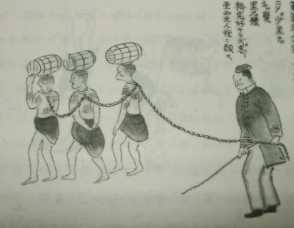
アメリカにも黒人奴隷はいたが、アフリカのロアンダ港(アンゴラ)で、ポルトガル人に首鎖でつながれてムチを打たれ、使われる黒人奴隷の姿に衝撃を受けた。
Slaves
The Japanese delegation observed the use of African slaves in the U.S.,
but they were shocked upon seeing African slaves bound in chains and whipped
by Portuguese slave traders during their stop in Angola.
▲奴隷(どれい) 小栗忠順従者・木村鉄太「航米記」
Slaves in “Kobeiki (Report on voyaging to the U.S.)” by Tetsuta Kimura, a member of the delegation who served as attendant to Tadamasa Oguri
■香港島 Hong Kong
香港島はアヘン戦争によってイギリスの租借地となっていた。上陸した日本人を一目見ようと群がる中国人を、整理する英国人警察官が、いきなり棍棒でぶちのめす島となっていた。
Hong Kong Island had been leased by the British during the Opium Wars.
It had become an island where British policemen, who were trying to organize
the Chinese who flocked to Hong Kong to catch a glimpse of the Japanese
who had landed, suddenly beat them up with clubs.
(英訳 Dennis
Clark. Translation by Dennis Clark)
|
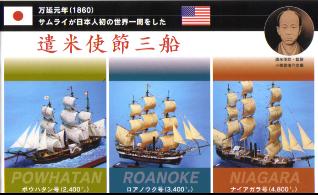


 模型制作:岡崎英幸・東善寺蔵
模型制作:岡崎英幸・東善寺蔵








 ポウハタン号POWHATAN
ポウハタン号POWHATAN ロアノウク号 ROANOKE
ロアノウク号 ROANOKE ナイアガラ号 NAIAGARA
ナイアガラ号 NAIAGARA






 模型制作:岡崎英幸・東善寺蔵
模型制作:岡崎英幸・東善寺蔵











 模型制作:岡崎英幸・東善寺蔵 Model created by Hideyuki Okazaki, Tozenji Collection
模型制作:岡崎英幸・東善寺蔵 Model created by Hideyuki Okazaki, Tozenji Collection
